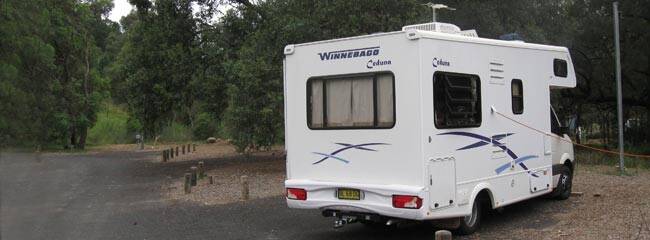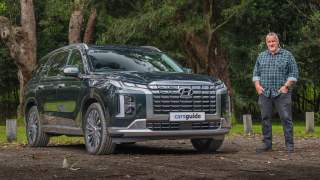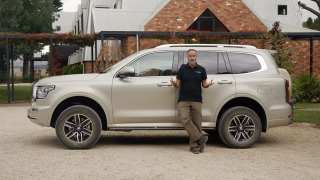
Winnebago Ceduna Highline review
Dream of packing it in and getting away from it all one day? That's exactly what we did at least for a couple of weeks on a rambling trip north to the dusty opal fields of Lightning Ridge in outback NSW.
Our weapon of choice was not a 4WD, but a 7 metre, 4.5 tonne 6-berth RV or motorhome just me and the missus.
This wandering lifestyle is the fastest growing segment of the Australian tourism market, injecting $60 million a week into the economies of rural towns, with some 390,000 RVs registered nationally of which 100,000 or more can be found on the road at any one time.
About 1500 RVs are sold each year in Australia and most of them are built by Winnebago (no relation to the US company of the same name) which has a 40 per cent share of the market.
Started in 1965, the family owned, Sydney-based company employs 200 people and sells around 600 campers and motorhomes each year, priced from $100,000 right through to $615,000. Our test vehicle the Ceduna Highline (they're all named after Australian towns) is one of Winnebago's new models.
SPECIAL LICENSE
You do not require a special licence to drive the majority of motor homes. It's determined by weight rather than the length. At 7.1 metres and 3.2 metres high the Ceduna is sizeable but because it weighs in at 4490kg a standard C Class car licence is all that is required. Stepping up from here you need a heavy truck, light rigid licence which is good up to 8 tonnes.
UNDERNEATH
This one rides on the back of a Volkswagen Crafter. Winnebago uses a variety of manufacturers, but this is the first VW based motorhome it has produced in a long time. It has a 2.5-litre five cylinder turbo diesel engine that produces 100kW of power and 300Nm of torque.
The engine is paired with a six-speed robotised manual gearbox that functions like an automatic. You can leave it in Auto or change gears manually but there's no clutch pedal. It must be in neutral before it will start and reverse is separated from the forward gears, we assume as a safety precaution.
FUEL ECONOMY
It has a 75-litre fuel tank. Fuel economy is a claimed 14.0 litres/100km. They reckon the sweet spot is around 90km/h where the engine is turning over at about 2500 revs. Anything above this and the economy is likely to blow out by 30 per cent.
It's slow going but we were in no hurry to get there. We averaged between 13.5 and 18.2 litres/100km over a distance of 2270km. Our overall average was 16.0 litres/100km. The price of diesel varied on our trip varied from $149.9 to 156.9 cents a litre, even in the wheat belt up north.
DRIVING
It's big and should be treated with caution. Take it slow and you won't get into trouble. There's plenty of vision with large exterior mirrors and line of sight through the rear window of the van.
The exterior mirrors also have a convex section at the bottom that gives a wider field of view when reversing. It's slow off the mark but once you hit cruising speed it's all plain sailing set the cruise control and crank up the music.
Traffic gives you a wide berth so there's plenty of time for making decisions. Don't try driving into any underground carparks because you won't fit. The driver's seat is not located over the wheels unlike a forward control van but you have to allow for the length. Don't forget to pack a GPS navigation device it will save arguments.
PARK OR PARK
You have the choice of staying in caravan parks or simply pulling up in a reserve or by the side of the road. Caravan parks are inexpensive at around $25 a night and mean you can hook up to their power and water and use their amenities (the shower in the van is a tight squeeze).
They also have "dump points'' to get rid of the nasty stuff that has been accumulating in the toilet. But the van is fully equipped for a night in the trees, with its own lights, water supply and gas to run the fridge and hot water. An awning unfurls from the side of the van but can be tricky to put up until you've done it a couple of times. After that it's time to get out the deck chairs and crack a cold one and admire the scenery.
WHAT YOU GET
Comes with all the mod cons, including a self-contained shower and toilet. The main queen-sized bed is motorised and drops from the ceiling at the touch of a button. It has another double bed over the cabin and the rear seats under the queen double as two singles, with seatbelts for six occupants.
There's a 150-litre fridge, gas/electric stove and microwave oven plus a digital, flat screen TV with built in DVD player. It needs to be tuned to the local stations every time you stop. Reception is crystal clear, with a wind up antenna. Did I mention the airconditioner (unfortunately it only works when you're connected to the power).
YUCKY STUFF
You need to drain the waste tank every couple of days and refill the water tank which holds 100 litres. Same goes for the toilet which has a sealed removable canister that is accessed via a door in the side. It has wheels and an extendable handle, just like a trolley bag. The idea is to wheel it over to the designated dump point, unscrew the cap and tip the yucky stuff down the hole.
Then it has to be rinsed, refilled with half a litre of fresh water and a sachet of chemicals added before it is replaced. It's not too messy and a small price to pay for the convenience.
HOW MUCH
Deep breath. The vehicle itself is worth about $52,000. Our test Ceduna is priced from $142,00 (more in some states). It comes with a five year structural warranty on the body, plus a two year/1 million kilometre warranty on any Winnebago components. The VW donor vehicle is covered by a 3-year factory warranty.
There's a big second hand market for motor homes and the good news is that if you look after it you can sell it again in 12 months for a similar amount to what you paid.
VERDICT
One of the main drawbacks of a camper or motorhome is the fact that you've always got it with you. You can't park it and head off to see the local sights after you arrive. One way around this is to tow a small car or 4WD because the Ceduna can tow up to a 2 tonne load. Then again you could simply buy a 4WD and tow a caravan instead.
One thing a motorhome is, however, is convenient. You can stop, walk through to the back, cook a meal, have a shower, watch a bit of TV and hit the sack all without having to leave the safety or comfort of the van.
The Ceduna is not perfect but it has much to offer. The bed is comfortable and there's plenty of room to cook or simply sit and relax. Getting into and out of the main bed can be awkward, especially trying to find the recessed foot hold in the dark.
We quickly bought a step ladder for the purpose which was much easier to navigate. There's also nowhere to sit if one partner happens to be an early riser because the bed when its in use covers the seating area.
The position of the reading lights also need some adjustment and it would be handy if they could be operated independently of the main switch. Both the airconditioner and water pump are also very noisy when operated.
All in all however life on the road is fun and has plenty to offer the adventure seeker, whether its a short trip or you fancy the nomadic lifestyle.

















